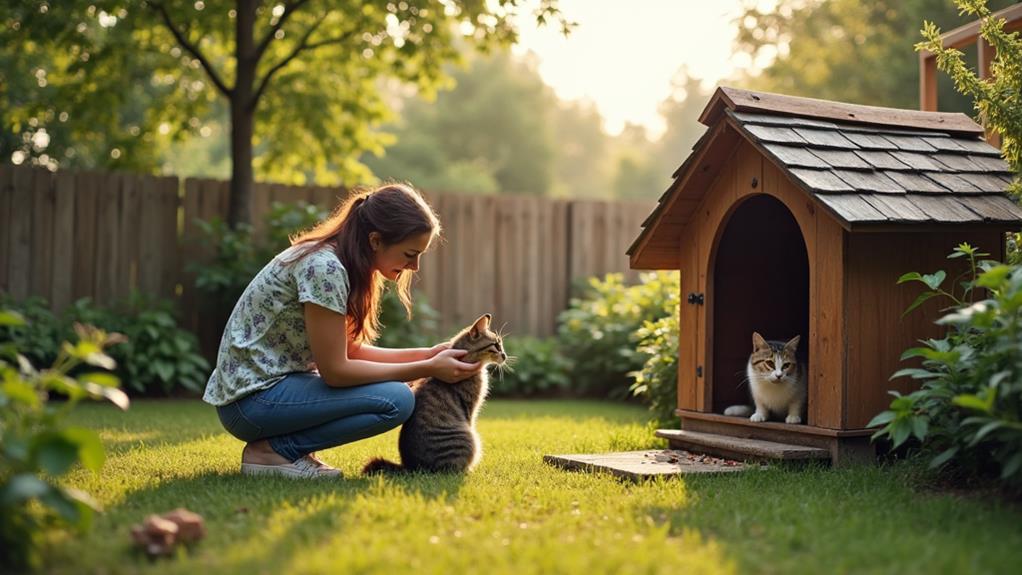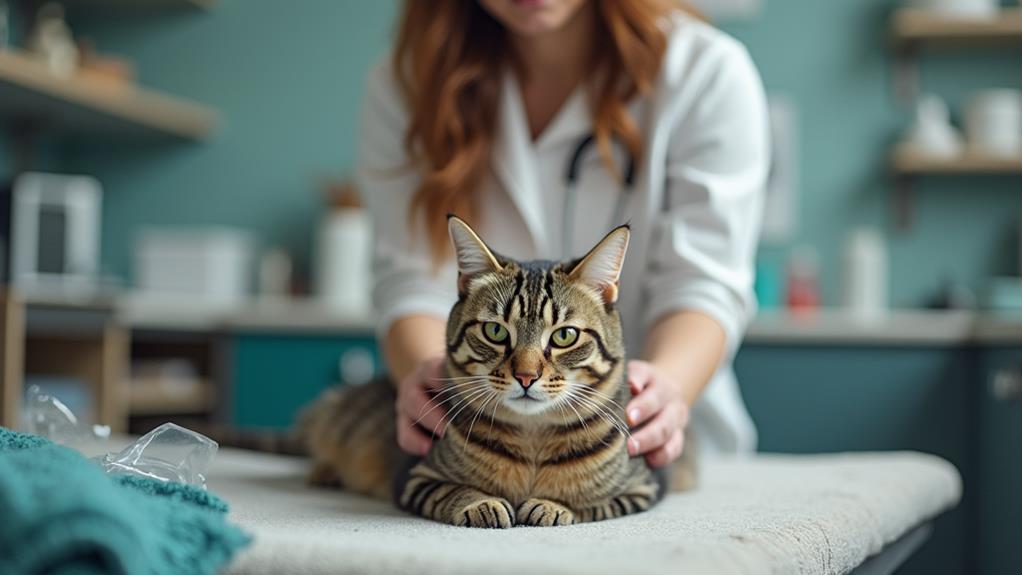How to Rehome a Feral Cat: Steps for Finding a Safe New Home

To rehome a feral cat, start by evaluating its behavior; remember they view humans as threats and need careful handling. Use humane traps for safe capture, and cover them to reduce stress. Arrange for spaying/neutering and vaccinations through a TNR program. Prepare a secure space in the new home with hiding spots and familiar items. Let the cat investigate gradually, maintaining a routine to build trust. Find committed adopters by reviewing their experience and home environment, and guide them on acclimating the cat. The expedition continues with more detailed tips on each step to guarantee a successful shift.
Assessing Feral Cat Behavior
How can you understand a feral cat's behavior? To start, recognize that feral cats are born without human contact, viewing you as a potential threat. When evaluating their behavior, pay close attention to their communication methods. Unlike domestic cats, feral cats often rely on body language, like hissing, to express discomfort or territorial claims. This makes understanding their non-verbal cues fundamental in building trust.
Trust-building with feral cats requires patience. Initially, you might observe fearful behaviors or avoidance. Over time, consistent, non-threatening presence can help them become more comfortable. Evaluate their hunting and foraging skills, which are key indicators of their natural instincts. These skills can also provide insights into their adaptability to new environments, helping you gauge their potential for indoor living.
Each feral cat possesses unique personality traits that influence how they interact with humans and adapt to a different environment. By closely observing their behavior, you can better understand their individual needs and how they communicate. This understanding is significant for successful trust-building, paving the way for a smoother change into a safe and nurturing home.
Safe Trapping Techniques
Capturing a feral cat safely requires thoughtful planning and the right tools. Start by selecting humane traps designed specifically for cats. These guarantee the feral cat's safety and comfort during the process. Next, bait the trap with enticing food like tuna or wet cat food. This enhances the chances of attracting the cat into the trap. Place the trap in areas where the cat is frequently seen to optimize success.
Timing is essential, so set the trap in the early evening or late afternoon. These are the most active times for feral cats, leading to higher capture rates. Once the cat is trapped, cover the trap with a towel or blanket. This step is important for stress reduction, as it prevents the cat from seeing potential threats and helps calm them down.
Monitor the trap regularly to confirm the cat isn't left inside for too long. Extended periods in the trap can lead to stress and potential harm. By following these safe trapping techniques, you can effectively capture a feral cat with minimal stress, making your next steps towards rehoming more straightforward and humane.
Veterinary Care Essentials

Guaranteeing a feral cat receives proper veterinary care is fundamental for its well-being and for community safety. Begin by arranging for the cat to be spayed or neutered through a Trap-Neuter-Return (TNR) program. This step is significant for controlling the population of community cats and reducing the number of kittens born in unsafe areas. Regular veterinary care, including vaccinations against diseases like rabies and feline distemper, is crucial. These vaccinations protect the cat and prevent the spread of illnesses within the community.
Health checks are another key component of veterinary care. They help identify any underlying issues that could affect the cat's well-being. Early detection allows for timely treatment, guaranteeing the cat can thrive in its new environment. Microchipping the cat provides a permanent form of identification, increasing the chances of them being returned if they become lost.
Here's what you can do to make a difference:
- Prevent suffering: Spay/neuter to stop unwanted litters.
- Promote health: Guarantee regular health checks and vaccinations.
- Provide security: Microchip to help lost cats find their way home.
Consider reaching out to an animal shelter for assistance in accessing these services.
Preparing the New Environment
Shifting a feral cat into its new environment requires careful preparation to guarantee its comfort and safety. Start by creating a secure, quiet space in the new home. Make sure this area is free from hazards and has plenty of hiding spots where the cat can feel safe as it adjusts. Crucial items like a litter box, food and water bowls, and a comfortable bed should be readily available. These basics will help the cat acclimate to its new surroundings.
Incorporate familiar items from the cat's previous home, such as toys or blankets. These familiar items can ease anxiety and create a sense of comfort in the new environment. Establish a consistent feeding schedule to help the cat build a routine and promote a sense of stability. This consistency fosters trust and makes the adjustment smoother.
Don't forget to monitor the cat's behavior closely during the initial adjustment period. Be patient; it may take several weeks for the cat to fully acclimate. By providing a safe and welcoming space, you're setting the stage for a successful change, ensuring the cat feels at ease in its new home.
Introducing the Cat to Indoors

Once you've prepared the new environment, it's time to introduce the feral cat to its indoor space. Start by giving the cat a quiet, secure space where it can acclimate without feeling overwhelmed. A separate room with familiar items like blankets or toys can create a comforting atmosphere. Gradual introduction is key—let the cat investigate its indoor environment over several days or weeks at its own pace, minimizing stress and allowing it to feel more at ease.
Establishing a consistent feeding schedule will help build trust. Feeding at the same times each day creates a predictable routine, letting the feral cat know it's safe and cared for. Keep an eye on the cat's behavior during this period.
Here are some steps to help ease the adjustment:
- Create Safe Zones: Provide hiding spots and vertical spaces so the cat can retreat and feel secure.
- Monitor Behavior: Watch for signs of stress or anxiety, such as excessive hiding or aggression.
- Maintain Patience: Keep in mind that each cat adjusts at its own pace; patience is essential for building trust.
Building Trust and Socialization
When building trust and socialization with a feral cat, patience is your best ally. Establishing a consistent feeding routine is vital, as it helps the cat associate you with safety and reliability. Regular meals create a predictable environment, which is fundamental for building trust. Use high-value treats like wet food or tuna to encourage the cat to approach you. These treats not only serve as a reward but also foster positive associations with your presence.
Create a safe space where the cat can retreat and feel secure. A confined area with cozy hiding spots reduces stress and allows the cat to observe you without feeling threatened. This environment is important during the initial stages of socialization.
Interactive play is another effective tool for socialization. Introduce toys gradually to engage the cat's natural curiosity and reduce its wariness. Play sessions can help the cat feel more comfortable around you, bridging the gap between fear and trust.
Identifying Committed Adopters

Finding committed adopters for a feral cat requires careful consideration and a strategic approach. You need to prioritize individuals who truly understand the unique needs of feral cats. Start by conducting thorough interviews to gauge the potential adopter's lifestyle and ability to provide a stable environment. It's essential they have a solid grasp of animal care principles and the patience necessary for the acclimation process.
Here's a checklist to help you find the right match:
- Experience and Understanding: Confirm potential adopters have experience with feral cats or a strong understanding of their behaviors. This knowledge is key to building trust and a lasting bond.
- Credibility and Commitment: Request references from previous pet owners or shelters. This step verifies their credibility and dedication to animal care.
- Home Visits: Consider visiting the potential adopter's home. This allows you to assess living conditions and confirm they can accommodate the cat's needs.
Encourage adopters to accept a gradual acclimation process. This illustrates their willingness to build trust and form a meaningful connection with the feral cat. By following these steps, you'll increase the chances of finding a truly committed adopter ready for this rewarding experience.




